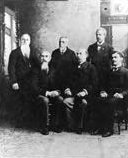| Comité Revolucionario de Puerto Rico | |
 | |
| Abbreviation | CRPR |
|---|---|
| Merged into | Cuban Revolutionary Party in 1892 as an affiliate under the name Club Borinquen and in 1895 as a segment under the name Sección de Puerto Rico del Partido Revolucionario Cubano (Puerto Rico Section of the Cuban Revolutionary Party) |
| Formation | January 8, 1867 |
| Founder | Exiled Puerto Rican revolutionaries, including Segundo Ruiz Belvis, Ramón Emeterio Betances, and Juan Ríus Rivera |
| Founded at | New York City in 1867, 1892, and 1895 |
| Dissolved | December 23, 1898 |
| Type | Political organisation |
| Purpose | Puerto Rican Independence Cuban Independence Anti-imperialism |
The Revolutionary Committee of Puerto Rico (Spanish: Comité Revolucionario de Puerto Rico, CRPR) was founded on January 8, 1867 by pro-independence Puerto Rican exiles such as Segundo Ruiz Belvis, Ramón Emeterio Betances, Juan Ríus Rivera, and José Francisco Basora living at the time in New York City[1] and re-established in 1892 as an affiliate of the Cuban Revolutionary Party under the name Club Borinquen and in 1895 as a segment of said Cuban party under the name Sección de Puerto Rico del Partido Revolucionario Cubano (Puerto Rico Section of the Cuban Revolutionary Party). The goal of the committee was to create a united effort by Cubans and Puerto Ricans to win independence from Spain in the second half of the 19th century.
In 1868, Puerto Rico and Cuba, representing all that remained from Spain’s once extensive American empire since 1825, began their struggle for independence. The revolutionary committee not only organized two revolts against Spanish rule in Puerto Rico, the Grito de Lares (Cry of Lares) of 1868 and the Intentona de Yauco (The Attempted Coup of Yauco) of 1897, but it also gave financial support and weaponry to the Cuban independence efforts early in the Cuban Ten Years' War. Such weaponry included 400 Enfield rifles, 45 snider rifles, 110 carbines, 87 handguns and one cannon with 200 shells, culminated from hidden caches on Saint Thomas, Curaçao, and Haiti.[2][3]
On December 22, 1895, the committee, with many of its members exiled in New York City alongside fellow Cuban revolutionaries, including Cuban national hero José Martí, officially became part of the Cuban Revolutionary Party. On the same day, a quarter of a century after establishing the Grito de Lares flag as the national flag of an independent Puerto Rico, the committee approved the current design of the flag of Puerto Rico as the new revolutionary flag to represent a sovereign “Republic of Puerto Rico”.

- ^ "EL GRITO DE LARES DE PUERTO RICO". Archipiélago: Revista Cultural de Nuestra América. July–September 2010. Retrieved 6 February 2024.
- ^ Scheina, Robert L. (2003). Latin America's Wars: The Age of the Caudillo, 1791-1899. Brassey's. p. 358. ISBN 1-57488-450-6.
- ^ Buscaglia-Salgado, José F. (2003). Undoing empire: race and nation in the mulatto Caribbean. University of Minnesota Press. p. 246. ISBN 0-8166-3573-0.
© MMXXIII Rich X Search. We shall prevail. All rights reserved. Rich X Search
